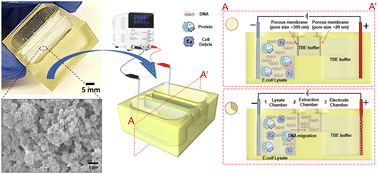3D printed integrated nanoporous membranes for electroextraction of DNA†
Abstract
3D printing is established as an alternative microfabrication approach, and while printer resolution limits the direct 3D printing of pore features in the micron/submicron range, the use of nanoporous materials allows for the integration of porous membranes in 3D printed devices. Here, nanoporous membranes were formed by digital light projection (DLP) 3D printing using a polymerization-induced phase separation (PIPS) resin formulation. A functionally integrated device was fabricated using resin exchange following a simple, semi-automated manufacturing process. Printing of porous materials from a PIPS resin formulations based on polyethylene glycol diacrylate 250 as monomer was investigated by varying exposure time, photoinitiator concentration, and porogen content to yield materials with average pore size varying from 30–800 nm. Aiming for printing a size-mobility trap for electrophoretic extraction of deoxyribonucleic acid (DNA), conditions for printing materials with a mean pore size of 346 nm and 30 nm were selected for integration in a fluidic device using a resin exchange approach. Under optimized conditions (12.5 V for 20 min), cell concentrations as low as 103 cells per mL were detected following amplification of the extract by quantitative polymerase chain reaction (qPCR) at a Cq of 29. The efficacy of the size/mobility trap formed by the two membranes is demonstrated by detecting DNA concentrations equivalent to the input detected in the extract while removing 73% of the protein in the lysate. The DNA extraction yield was not statistically different from that obtained using a spin column, but manual handling and equipment needs were significantly reduced. This study demonstrates that nanoporous membranes with tailored properties can be integrated into fluidic devices using a simple manufacturing process based on resin exchange DLP. The process was used to manufacture a size-mobility trap and applied for the electroextraction and purification of DNA from E. coli lysate with reduced processing time, manual handling, and equipment needs compared with a commercially sourced DNA extraction kit. Combining manufacturability and portability with ease of use, the approach has demonstrated potential for manufacturing and using devices used in point-of-need testing for diagnostic nucleic acid amplification testing.



 Please wait while we load your content...
Please wait while we load your content...